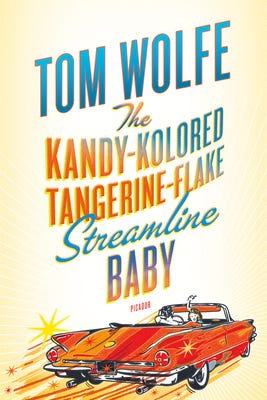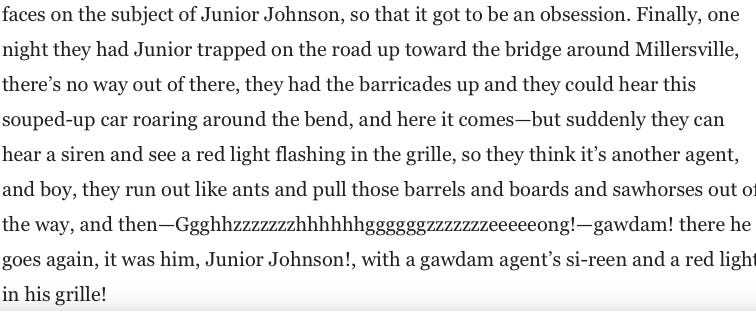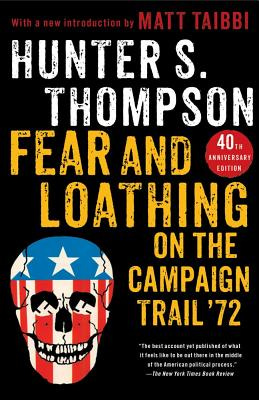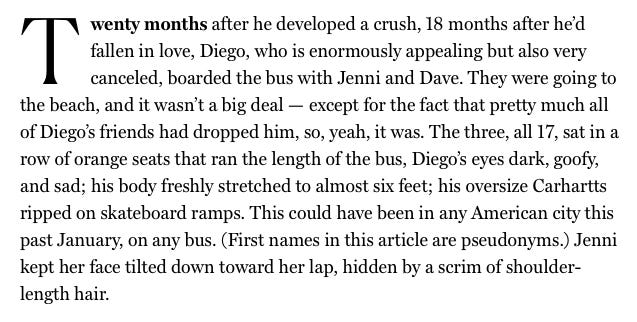When I was young, arguably too young, I was besotted with the New Journalism of Tom Wolfe, Hunter S. Thompson, Norman Mailer, et al…
At some point around eighth or ninth grade I pulled The Kandy-Kolored Tangerine Flake Streamline Baby, a collection of Tom Wolfe’s pieces which originally appeared in Esquire, from my parents’ bookshelf and started reading. I’m not sure what drew me to it - maybe just the title, or maybe I’d seen my older brother reading it - but I found the stories instantly compelling.
My favorite was a piece on Junior Johnson (“The Last American Hero Is Junior Johnson. Yes!”), the stock car racer, that was set in a single day at a race, while weaving in the origins of stock car racing in the moonshine trade of the American South. I have no idea how accurate or true any of the story is - probably not very - but it didn’t matter, it was a good story, well told, which is all that mattered to me. Even when I could not fully appreciate the underlying dynamics of Wolfe’s subjects - 60’s political radicals, or the LSD experimentation of Ken Kesey and the Merry Pranksters (for example) - I still loved them.
I loved them because of the craft that was employed in the service of telling those stories, particularly the way imagery was employed, and how New Journalists like Wolfe would use a close, subjective third person point of view to capture the subject being profiled.
Here’s the first paragraph from Wolfe’s piece on Junior Johnson as it appeared in Esquire. There is very little concrete sense making in the prose, but the way he piles the images on top of each other was very inviting to me as a young reader. Still is.
Do those colors even exist? Who cares? The energy is irresistible. I don’t really know what’s going on, but I want to find out.
And here is an example at the end of a passage recounting Johnson’s origins as a moonshine runner evading the police and federal agents. Notice how Wolfe uses voice and point of view to capture a kind of Southern Man “character” who properly appreciates the driving genius of Junior Johnson.
Rather than posing as an objective/authoritative voice of journalistic detachment, Wolfe instead ventriloquizes the voices of these good ole boys into the narrative. The authority and authenticity are rooted not in cool remove, but in passionate extreme closeness. The illusion is that we’re getting the story straight from the source, without the interference of the journalistic framing and interpreting. On purpose, the New Journalists turned journalism on its head.
But of course, Wolfe is conjuring an illusion. No source he spoke to told him this story this way. You don’t see any quotation marks. Wolf was a southerner (born and raised in Richmond, Virginia), so he’s not slumming here, but he was also writing about the South for an audience of urban sophisticates, and this undoubtedly shapes the telling, turning his subjects into big ole characters.
The New Journalists would say that they were trading strict accuracy for something more important, capturing “truth,” which is more the stuff of fiction than non-fiction, but who cares if you’re getting a good story, well-told?
And in terms of truth, they had a case. Hunter S. Thompson’s Fear and Loathing on the Campaign Trail ‘72 eviscerates the style of campaign journalism prevalent at the time (and that’s really no different today) that frames events as media stories and political horserace coverage subject to “pack journalism,” as opposed to focusing on the actual human stories underneath. Anything you’ve read over the last few days doing political “analysis” following the overturning of Roe v. Wade follows the same pattern Thompson was seeking to explode.
That Thompson deviated from objective facts seems a minor sin next to the broader social commentary he developed in his work. In fact, it isn’t a sin at all.
I was so fascinated by these things I not only decided to write my junior-year high school English term paper on Tom Wolfe, I wrote the thing in the style of Tom Wolfe. This did not go well, grade wise, but it was by far the hardest I’d ever worked on a piece of writing up to that point. (For a fuller version of the tale, you can check out this piece by me at Inside Higher Ed.)
It is these craft choices, rooted in specific values that makes these classic pieces of New Journalism such compelling reading, even today: “truth” over strict “accuracy;“narrative” over what I would call “coverage” (making sure to include the perspectives of all involved), “voice” over “objectivity.”
New Journalism had a salutary effect on nonfiction overall by making narrative more central to to the telling, even creating a new genre of “narrative nonfiction.” It’s important to understand that these craft choices are rooted in a set of values (see above), and that by making certain choices, compromises are made. All of these things also exist on a continuum.
Michael Lewis (The Big Short, Moneyball) has echoes of New Journalism in the way the makes specific characters central to the stories he tells. He is not attempting objectivity, though in general, he holds himself to a greater standard of accuracy than someone like Hunter Thompson. Still, there are limits to this method when it is not well-suited to the subject matter. Lewis’ book on the coronavirus pandemic (The Premonition) is by far the weakest of his oeuvre, picking specific heroes in a story that’s far too complicated for his usual method.
Or consider a writer like Patrick Radden Keefe (Empire of Pain: The Secret History of the Sackler Dynasty). His nonfiction has strong narrative elements, but he is also more interested in complete “coverage” of his subjects than someone like Lewis. He expects the underlying facts and inferences of his reporting to be more strictly scrutinized, so while narrative is present, it isn’t as tidy a story as Lewis often tells.
Joan Didion (Slouching Toward Bethlehem) threaded the needle as interestingly as anyone, stitching together a blend of personal essay, journalism, and cultural commentary that is often lumped in with the New Journalism, but also has always stood apart.
David Foster Wallace’s nonfiction (A Supposedly Fun Thing I’ll Never Do Again) has always struck me as an attempt to blend the close observation and cool commentary of Didion with the manic energy of Thompson and Wolfe to highly entertaining effect provided you don’t take any of it as gospel.
It’s also important to note that even the most scrupulous reporting does not achieve “objectivity.” Journalists who claim objectivity are lying to either the reader, themselves, or both. Objectivity is often used as a shield to protect the writer from criticism (e.g., “Just going where the facts lead”) and if a writer insists that they’re objective, you should be very suspicious of what they’re trying to obscure from their readership. The choices a writer makes inevitably introduce subjectivity and bias into the story being told. This is actually a feature, not a bug, provided the writer is focused on being thorough, transparent, and fair.
The way the elements of fiction and nonfiction have blended make for a richer array of work, even as it can be trickier to discern differences between the two. Alex Haley’s Roots was published as a historical novel, but I think most readers today would read it through the lens of nonfiction. Haley called it “faction.”
There is no universal correct craft choice, and even within the context of specific material, specific stories, there’s a lot of choices that are likely to work just fine. If you come up with a good story, well told, you’re usually in pretty good shape.
But there are also examples of a tragic mismatch between craft and material.
One was published this past week.
On the cover of New York magazine, the story is titled “Cancelled at 17: When Kids Make Mistakes and Classmates Never Forgive,” written by longtime journalist Elizabeth Weil. It is the primarily the story of “Diego” (a pseudonym) who made this “mistake” and was ostracized at his school, as were some of the students who supported Diego. It is a complex and complicated story about teenage social dynamics, social media, the impact of COVID on students, and the failure of the adults in charge to properly handle this complex and complicated situation.
The published story, as told by Weil, is a catastrophic misfire. I am actually sort of dumbfounded that it made it through layers of editorial oversight and appears in a major magazine.
Whatever one thinks about cancel culture or leftist excesses, the story is a bad choice to try to make a larger point by using a central character as an example of a broader phenomenon.
The most prominent mistake is Weil’s choice to bury the reason why Diego has come in for social sanction, sharing private nude photos of his girlfriend to others at a party without her consent.
As a whole, the piece seeks to paint a culture of excess in the social sanctions that Diego experienced for this act. The school gets chaotic with lists of boys to avoid going up in bathrooms and walkouts and clear choosing of sides which results in Diego’s one-time girlfriend also experiencing some measure of bullying and ostracizing. The principal and other adults are painted as overwhelmed and ineffectual, a tidal wave of student emotions leaving them paralyzed to act.
While there is little doubt that events at the school spiraled out of control, the article also misses an opportunity to situate what is happening to Diego in the larger context of longstanding problems many schools have with keeping female students safe from sexual harassment and sexual assault. The vigilantism that arrises in the vacuum can be seen as a backlash to years of institutional failure. Weil’s approach obscures this larger context and instead paints a portrait of a kind of run amok frenzy of “social justice.”
I could go on about how strange the story is on this front, but others have done it better than I could, including Jessica Valenti at her newsletter, and Tarpley Hitt at Gawker, who fills in lots of the missing context that Weil excludes.
I was also brought short by this story from Carter Sherman at Vice who covers a longstanding problem at a Charlotte, North Carolina school district which has been investigated multiple times for its failure to protect students from sexual harassment, including female students being sexually assaulted on school grounds.
I am open to the idea that Diego might have suffered more consequences than warranted by his transgression, and that we should be broadly concerned about the potential for student-led social justice movements to result in the kind of bullying and harm that they seek to redress on the behalf of others, but the piece itself is just exceedingly odd in the way it wants us to believe that Diego should be the source of a kind of unfettered sympathy, forgiven as soon as we learn his transgression, and further that Diego is emblematic of a larger phenomenon in schools.
This failure is embedded in the choices of craft that Weil makes, many of which are rooted in the techniques of the New Journalists. Consider her opening paragraph:
Weil uses the same close, subjective point of view as Wolfe, incorporating a kind of teen speak (almost a parody of it, actually) to bring us close to Diego, then pivoting to suggest that Diego’s story isn’t just about Diego, but could be happening anywhere.
Later, she uses the technique of piling image upon image to give us a portrait of Diego and then his relationship with his girlfriend, “Fiona.”
Diego is shown as a kind of innocent, fan of both Nivea and Taylor Swift, close to his parents, and with a more who is open enough to talk to her teenage son about consent. This isn’t a troglodyte bro looking to make women his conquests. In this portrait, this is a clearly sensitive kid who deserves sympathy for his mistake.
Notice especially how Weil chooses to describe Fiona from (apparently), Diego’s point of view: “psychedelically beautiful,” with the power to make “even the pandemic okay.” We are meant to see Diego as a character who is transfixed by Fiona, both because of her physical beauty and her spiritual power to make him feel better. The paragraph above comes right before the disclosure of Diego’s transgression:
“Showed the nude of his beautiful girlfriend.” This deliberate choice by the author to include “beautiful” here in a passage inhabiting Diego’s point of view is a suggestion that Diego’s motive was not to brag or posture to his friends, or to shame Fiona, but simply because he was so overwhelmed with his girlfriend’s beauty he had to share it with others.
The way Weil puts her thumb on the scale here is transparent, and it is the kind of thing that the New Journalists did repeatedly. Why does it seem so objectionable here?
Mostly, I think it’s because of that missing context around what’s happening in schools when it comes to young women and sexual harassment and sexual assault.
But also, this is an adult journalist ventriloquizing and interpreting the life of teenagers in the service of a larger agenda. It is, for lack of a better word, weird. On what planet is this story well-served by attempting to wedge it into the larger cultural tug-of-war over “cancel culture.”
Is the message that we should be more laissez-faire about these things? This seems like a difficult position given that there are hundreds of stories about female students being “slut-shamed” after nude selfies of them have surfaced, forcing them to withdraw from school entirely. Is this message that the pendulum has swung so far the other way that the students sharing those photos are being punished too severely? Does that seem plausible? Is this a journalist using the techniques of the New Journalists to render a larger truth?
In the opening paragraph, Weil herself says that this is a story that could be happening anywhere, and she’s right! That this is true conveys extra responsibility on the author and publication to take care with the story to be fair, thorough, and transparent.
At a craft level, making Diego central to the story, using techniques that seek to make our connection to him even closer than we would be otherwise are simply very bad choices that obscure more than they reveal.
I primarily see this as an editorial failure. I am a strong proponent of writers taking big swings at big subjects, but if I had received this piece from a writer I was working with, I would’ve cautioned them that they were walking a very narrow ledge, and indeed had fallen off.
It would be nice if this could be a learning moment for all of us, but the unfortunate dynamics that have informed the “cancel culture” metanarrative in a way that has elevated that metanarrative above the underlying events on the ground have been furiously churning since the story was published. Weil has been subjected to both substantive criticism and over-the-top harassment, and has apparently deleted her Twitter account. To the extent that this post may be fanning the meta debate about cancel culture, I’m guilty too.
Diego’s story is worth knowing, but when the craft is out of sync with the needs of the story, you get a mismatch between craft and subject that can have disastrous consequences indeed.
Links
My Chicago Tribune column this week is my picks for the best books of the year (so far). Regular readers can probably guess some of the selections, but there might be a couple of surprises as well. I’ve made a temporary Bookshop.org bookshop with all of them collected in one spot for your digital browsing/buying convenience.
You will not find a better example of how to match careful attention to craft with complicated subject matter than this must read piece from Marcela Valdes going “Inside the Push to Diversify the Book Business.”
In honor of the last week of Pride Month, a list of 111 Queer Books, recommended by various book loving people.
First, you should spend a few minutes trying to think of the “25 most significant New York City novels from the last 100 years,” then you should go to the New York Times to see how your thoughts compare with theirs.
This Twitter thread from horror writer Tonia Ransom shows that any medium can be used to tell a good story.
Recommendations
All books linked here are part of The Biblioracle Recommends bookshop at Bookshop.org. Affiliate income for purchases through the bookshop goes to Open Books in Chicago.
Affiliate income is $143.05 for the year.1
1. The Collector by John Fowles
2. The Woman in the Dunes by Abe Kobo
3. Log of the S.S. The Mrs. Unguentine by Stanley Crawford
4. Slow Man by J.M. Coetzee
5. Room by Emma Donoghue
Jim H. - Atlanta, GA
I think Jim might enjoy a classic novel with a classic anti-hero: Journey to the End of Night by Louis-Ferdinand Celine.
1. Chicago by Brian Doyle,
2. Girl, Woman, Other Bernadine Evaristo
3. Before the Coffee Gets Cold, Tales from the Cafe by Toshikazu Kawaguchi
4. Olive Again by Elizabeth Strout
5. Three Junes by Julia Glass
Ann F. - Marquette, MI
For Ann, I’m recommending a novel from a few years back which made a big splash, but seems to have faded almost entirely, including in my own mind, until I was reminded of it recently when retrieving my copy that had fallen behind a shelf. The Nix by Nathan Hill.
Phew! A bit of an epic one. If you’ve read this far, perhaps consider a paid subscription so this enterprise remains a sustainable proposition.
I won’t be doing a newsletter next week because of the holiday weekend, but mostly because Mrs. Biblioracle and I are moving to a new house next Friday and I probably won’t be able to locate my computer amongst the mess until at least Monday.
I’ll see you all in a couple weeks.
John
The Biblioracle
I’ll match affiliate income up to 5% of annualized revenue for the newsletter, or $500, whichever is larger.












I think trying to bring us close to Diego from the first paragraph works great. The real issue is excusing him from his mistake from the moment it is told. A much more compelling narrative would go something like this: 1. Diego is a decent guy, readers feel sympathetic towards him; 2. Diego fucks up badly, girls are affected by this kind of behavior constantly, readers feel contempt; 3. Consequences for Diego start getting out of hand, even readers who wished him to be punished think “hey, wait a minute, that’s taking it too far.” This arc would fulfill the greater purposes of a) showing how girls suffer from sexual harassment even from decent-looking guys and b) advocating that cancel culture can get out of hand.